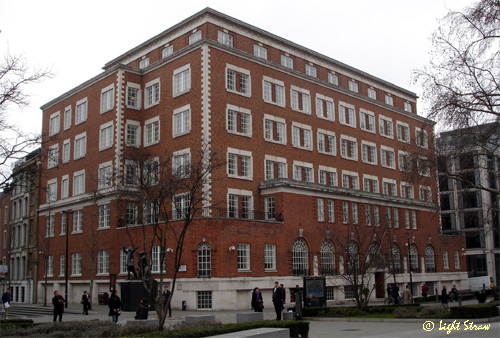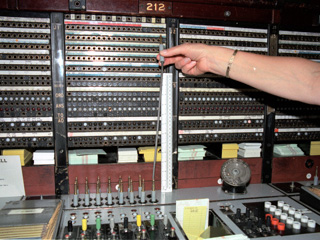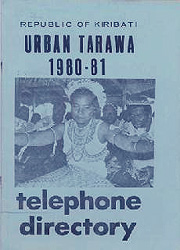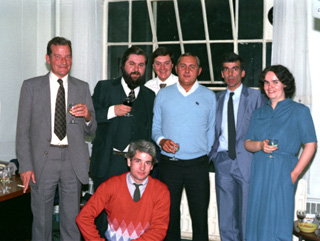...in the shadow of St. Pauls.
 |
Originally constructed in 1933, the former carpet/textile warehouse was leased by the GPO in 1963 to become a new international operator centre. |
The Building
Foundation stone laid 2 November 1933 by Ralph Montagu Cook JP.
Upon transfer to the GPO, Wren House adopted the name of its earlier building at 27-30 St. Paul's Churchyard, which had been demolished during the creation of Carter Lane Gardens.
Wren House at 15 Carter Lane, London, comprised of seven floors:
|
Ian Cairns [Tpst/N in Wren House 1965-1979] explains, "On the 3rd floor the Ticket Dispatch Office was relocated away from the Building and other departments to the 4th floor. The 3rd floor was then used for Locker Rooms and the Games Room. The 4th floor was used for the Exchange Clerical Office and the Training Department."
Malcolm Knight [STS in Wren House 1981-1984] concludes, "The Ticket Office was relocated to Wren House during my tenure, but why it had been housed elsewhere and how we squeezed it back in I no longer remember. It was a large room, possibly half the size of a switchroom, dealing not only with Wren's own tickets but also the constant flow of billing information for all of the UK's international transfer charge calls. Because of the revenue implications of any loss or delay the unit was frequently the subject of management interest which may explain why I recall a somewhat mixed reaction from the staff when calling in there on my last day. Karen W excepted of course, who was as friendly and conscientious as usual."
107/108 Service
The 'on-demand' service to North America was launched on 8th July 1968 and allowed London subscribers to dial an international operator without having to go via their local operator. And the call no longer had to be reverted back. [Link to delay working].
Subscribers dialled 107 for ordinary calls and were connected directly with an international operator in Wren House who completed the call, 'on-demand' - no booking or calling back was required.
Subscribers dialled 108 for personal and miscellaneous calls and the operator rang back once the called person was on the line.
Ticket Despatch Office
The Exchange Manager (1981-1984) recalls...
"The ticket despatch office, situated on the west side of the building, was the biggest part of the third floor, but not because of the number of tickets produced by the Wren House operators. The unit was responsible for processing the data from all 'collect' (transfer-charge) calls from every country worldwide. Consequently, the data for all incoming collect (transfer-charge) calls from abroad to UK chargeable numbers ended up in Wren House. The details were transcoded onto ISOCC tickets, which were later despatched to a ticket reading centre, to be passed through the UK billing system to raise charges. Collect calls from the USA to the UK accounted for a large proportion of this traffic, and thus from about 1987 the process was computerised. No more tickets; the USA fed our billing systems directly and vice versa."
The Switchrooms
Wren House dealt only with Inter-continental calls from four switchrooms located on the first and second floors:-
|
 |
The switchrooms ran from the front (i.e.. looking at St Paul's) right through to the back. Apart from the toilets and stairs, the whole of the first and second floor was 100% switchroom. |
| The Canteen | |
 |
With over 1000 operating & clerical staff, food and refreshments were an important part of the working environment. |
| Operating Procedures | |
 |
A look at the keyshelf, jackfields and operating procedures. |
| International DQ | |
 |
The Wren House International DQ library contained over 500 directories covering most parts of the world including... Republic of Kiribati - Urban Tarawa 1980-81 - This example, rescued from the DQ on its closure in 1983, consisted of a mere 28 type-written pages over half of which were for numbers within government offices. The preface makes interesting reading too. |
Wren had very few managers. It started with Peter Glanville, John Brown and Roy Potter, then Brian Hordle, usually called Major Hurdle because of his Territorial Army connections, Graham McCubbin, Malcolm Knight from 1981 to 1984 and finally Gerry McGarrity from 1984 until closure in 1988 . During his term, Brian Hordle was manager of both Wren and Faraday 2A.
The Management Team (1982)
Malcolm Knight is shown (below) with some of his team who tried to run the exchange efficiently and give as good a service to the customers as possible. Not an easy job, as industrial relations were only just beginning to show signs of improvement after the troublesome seventies and IDD had not yet made its mark on any 'third world' country. Route congestion and delay was the norm.
The End
The lease on Wren House was due to expire in 1992, but the landlord offered British Telecom a large sum to vacate the building early so that it could be developed. It therefore closed in 1988. The equipment was quickly stripped out and complete refurbishment took place soon after. It is thought that a planning requirement (or adjoining buildings) prevented demolition, so the interior was gutted leaving only the shell. It was then rebuilt by its new owner and leased to companies such as BANCA SAN PAOLO IMI SPA.
By the end of the Eighties, a more modern call centre had opened in Kelvin House, Judd Street.
 |
The Wren House pages are dedicated to the memory of Fred Dowry, who died (at the tragically young age of 49) en-route to see his beloved Tottenham Hotspur play away on 25 January 2004. |
The story would not be complete without a mention of the 'Cybermen Invasion' which marched down the steps of Peter's Hill (opposite St. Paul's) around September 1968. Perhaps they were simply off-duty telephonists? The Doctor, Jamie and Zoe knew better.
Page last updated 26 Nov 2018. Checked May 2021.
All logos and trade marks are the property of their respective owners and are used on the Light Straw site(s) for review only. Students and researchers are recommended to make their own independent enquiries as to the accuracy of the information contained therein.
